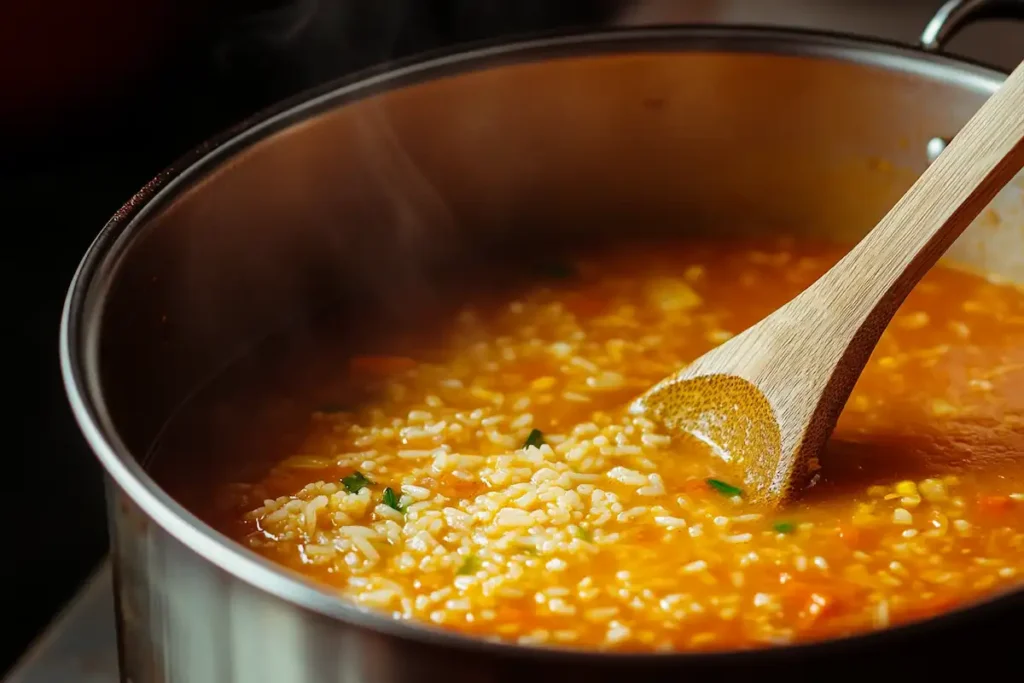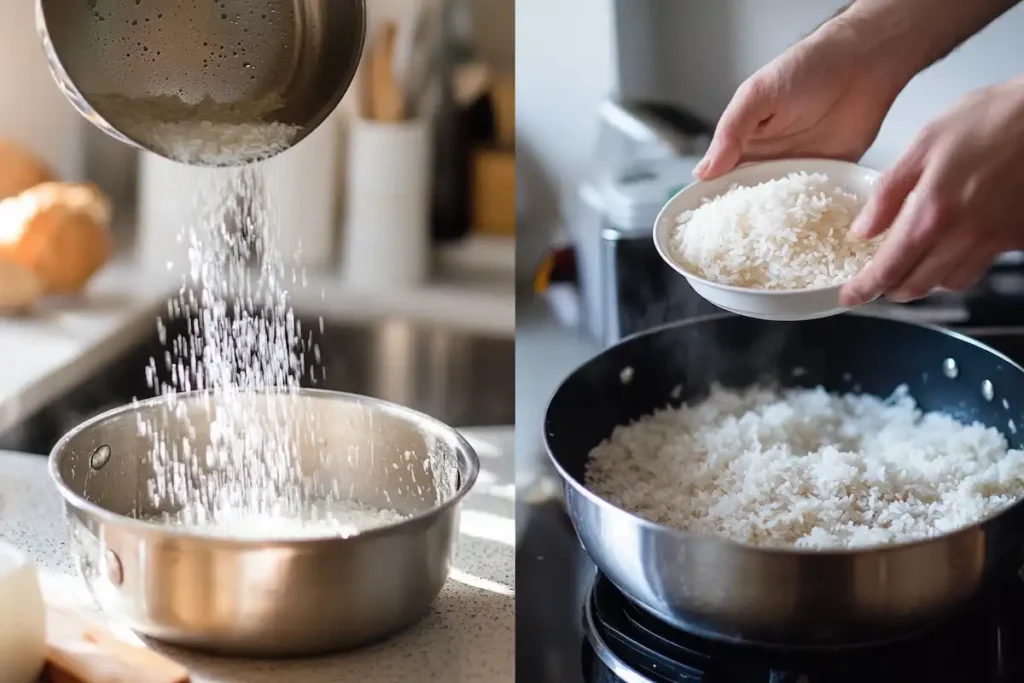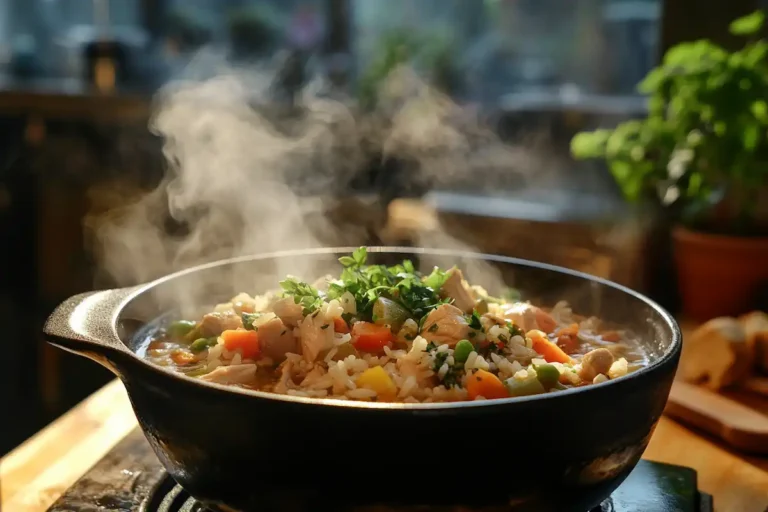Soup is a comfort food enjoyed worldwide, and rice is a popular ingredient that adds heartiness and texture. But the question remains: Should you cook rice before adding to soup? Some home cooks prefer adding uncooked rice directly into the broth, while others insist on pre-cooking it separately. The choice can significantly impact the soup’s taste, texture, and consistency.
In this comprehensive guide, we’ll explore why pre-cooking rice might be the smarter option. You’ll discover the benefits of cooking rice separately, common mistakes to avoid, and the best rice varieties to use in soups. By the end, you’ll know exactly how to make the perfect bowl of soup without ending up with mushy or overcooked rice.
1. Introduction
Cooking rice for soup might seem like a straightforward process, but it actually requires careful consideration. Should you cook rice before adding to soup? This question arises often among home cooks because the choice between adding raw or pre-cooked rice can significantly impact the final dish’s taste and texture.
Why Rice is a Popular Soup Ingredient
Should you cook rice before adding to soup? when it’s already such a popular ingredient? Absolutely! Rice is a versatile grain that enhances soups by adding bulk and making them more filling. Whether you’re preparing a hearty chicken and rice soup or a delicate broth-based dish, rice provides a comforting texture while absorbing the flavors of the broth beautifully.
When adding rice to soup, it’s important to consider whether to pre-cook it or allow it to cook directly in the broth. Many people wonder: Should you cook rice before adding to soup? or does cooking it raw yield better results? The answer depends on the type of rice and the soup recipe you’re following.
Boosting Flavor and Texture
Cooking rice separately before adding it to soup allows for better control over texture. It prevents the grains from absorbing too much liquid, ensuring they remain firm and distinct. On the other hand, adding raw rice directly may result in a thicker, starchier soup—prompting the recurring question: Should you cook rice before adding to soup? for optimal consistency.
Different rice varieties bring unique characteristics to soups:
- Long-grain rice remains firm and separates easily.
- Short-grain rice contributes a creamier, thicker texture.
- Brown rice offers a nutty flavor and extra nutrients.
- Wild rice adds an earthy taste and chewiness.
The Ongoing Debate: Cooked vs. Uncooked Rice
There’s a divide among home cooks—some argue that adding uncooked rice allows it to soak up the soup’s flavors, while others believe it absorbs too much liquid and can turn mushy. On the flip side, cooking rice separately gives more control over texture and prevents the soup from becoming overly thick or starchy.
What This Article Will Cover
In this article, we’ll cover:
- Why you should cook rice before adding it to soup.
- The best types of rice for soups.
- Tips to prevent mushy rice.
- How to achieve the perfect balance of texture and flavor.
Stay tuned as we explore the best practices for adding rice to your favorite soups.
2. Should You Cook Rice Before Adding to Soup?
Cooking rice for soup can be a tricky decision, and many wonder: Should you cook rice before adding to soup? While adding uncooked rice might seem convenient, it can greatly affect the dish’s texture and consistency. Let’s break down the advantages and disadvantages of both methods.
Pros and Cons of Cooking Rice Separately
Cooking rice separately offers several advantages:
- Control Over Texture: When rice is cooked separately, you can achieve the perfect texture—whether you prefer it fluffy, firm, or slightly chewy.
- Prevention of Overcooking: Soup often simmers for an extended period, which can turn rice mushy if added raw.
- Balanced Liquid Levels: Pre-cooked rice won’t absorb excessive broth, maintaining the soup’s desired consistency.
- Easy Storage: Leftover soup with pre-cooked rice stays fresher longer since the rice doesn’t continue absorbing liquid over time.
On the other hand, cooking rice separately may require additional time and effort. Some cooks prefer to cook it directly in the soup for convenience. However, this method often leads to challenges.
Does Uncooked Rice Absorb Too Much Liquid?
Uncooked rice acts like a sponge, drawing in liquid from the soup. This can lead to a thicker consistency than intended, and in some cases, the soup might become too dry. Additionally, you might find yourself constantly adding more broth, which can dilute the flavors.
If you’re preparing soups such as chicken and rice soup or vegetable rice soup, it’s best to consider the impact of liquid absorption before adding uncooked rice.
Impact on Texture and Flavor
Adding raw rice directly to soup may seem like an easy option, but it often results in inconsistent textures. Some grains may become too soft, while others remain undercooked. Cooking rice separately ensures that it absorbs flavors properly without overpowering the soup.
For a perfectly balanced soup, cooking rice separately is usually the better option. It allows the broth to shine without being overwhelmed by starch.
Related Recipe: If you’re looking for a delicious rice soup recipe, check out this Chopt Spicy Chicken Soup Recipe with Rice.
3. Powerful Reasons to Cook Rice Before Adding to Soup
Now that we’ve explored the pros and cons, let’s dive into the top reasons why pre-cooking rice is the best approach.
1. Better Texture Control
Cooking rice separately allows you to achieve the perfect texture. Whether you want it firm, fluffy, or tender, pre-cooking ensures consistency without the risk of overcooked or mushy rice in your soup.
Tip: Use long-grain rice for soups if you want separate, non-sticky grains.
2. Avoid Over-Absorption of Broth
One of the biggest issues with adding raw rice is that it absorbs too much liquid, making your soup thicker than intended. Cooking it separately ensures the broth remains well-balanced and flavorful.
Pro Tip: If you prefer adding uncooked rice, slightly increase the broth to maintain the soup’s consistency.
3. Enhanced Flavor Absorption
When rice is cooked separately and added later, it absorbs the rich flavors of the broth without becoming too starchy. You can even cook the rice in broth beforehand to give it an extra burst of taste.
4. Reduced Cooking Time and Convenience
Pre-cooking rice means your soup can come together quickly. Instead of waiting for rice to cook fully in the broth, you can simply reheat and serve, making it ideal for busy weeknights.
Pro Tip: Batch-cook rice and store it in the fridge for up to a week to save time.
5. Preventing Soggy or Mushy Soup
No one likes mushy rice in their soup! Cooking rice separately eliminates the risk of overcooked grains turning into an unappetizing mush, ensuring a pleasant texture in every spoonful.
4. Common Mistakes When Adding Rice to Soup

Adding rice to soup may seem simple, but many home cooks make common mistakes that affect the final dish’s quality. So, should you cook rice before adding to soup? Understanding these pitfalls can help you make better decisions and achieve the perfect consistency and flavor.
Using the Wrong Type of Rice
Not all rice types work well in soup. Some varieties, like short-grain rice, tend to become too sticky, turning your soup thick and starchy. On the other hand, long-grain rice holds its shape and stays separate, making it ideal for brothy soups.
Common mistakes include:
- Using instant rice, which often turns mushy quickly.
- Choosing sticky rice varieties, which can cloud the broth.
- Not adjusting cooking times based on the rice type.
To avoid these mistakes, consider using long-grain options like basmati or jasmine rice, which maintain their structure even when reheated.
Not Adjusting the Liquid Ratio
Rice absorbs a lot of liquid, and failing to account for this can leave you with a thick, overly starchy soup. If you’re adding raw rice, you must increase the broth to compensate for the absorption.
How to fix this mistake:
- Add an extra cup of broth for every half cup of raw rice added to the soup.
- If the soup thickens too much, gradually add warm broth to restore consistency.
If you’re looking for a perfectly balanced rice soup recipe, check out Chopt Spicy Chicken Soup Recipe with Rice for inspiration.
Overcooking the Rice
Overcooking is a common problem when rice is added directly to the soup. Cooking rice for too long results in mushy, unappetizing grains that break apart and ruin the texture.
Prevent overcooking by:
- Cooking rice separately and adding it just before serving.
- Using parboiled rice, which holds its shape longer.
- Simmering the soup gently rather than boiling vigorously.
5. The Best Types of Rice for Soup
Choosing the right rice can make all the difference in how your soup turns out. Different rice varieties offer distinct textures and flavors, so it’s crucial to select the best fit for your recipe.
Long-Grain Rice: The Best Choice for Most Soups
Long-grain rice, such as basmati and jasmine, is a top choice for soups. These varieties stay separate, cook evenly, and absorb broth flavors without turning mushy.
Why long-grain rice is ideal:
- It stays firm even after simmering.
- It doesn’t make the soup too thick or starchy.
- It works well for clear, broth-based soups.
Short-Grain vs. Medium-Grain Rice
Short-grain rice, like arborio, is commonly used for creamy soups due to its high starch content. Medium-grain rice, such as Calrose, falls somewhere in between, offering a soft texture without becoming overly sticky.
When to use short- and medium-grain rice:
- For thick, hearty soups like chowders and stews.
- When you want a slightly creamy consistency without adding dairy.
- In recipes that require a longer simmering time.
Brown vs. White Rice: Which is Better?
Many people wonder whether to use brown rice or white rice in soup. Brown rice offers more nutrients and a nutty flavor, but it takes longer to cook compared to white rice.
Comparison:
- Brown rice – Higher fiber, longer cooking time, earthy flavor.
- White rice – Cooks faster, softer texture, neutral taste.
If you’re short on time, consider using parboiled brown rice, which cooks faster while still offering health benefits.
Wild Rice and Specialty Grains
Wild rice is an excellent choice for soups that need a chewy texture and a nutty flavor. It pairs well with vegetable-based soups and adds a unique touch to classic recipes.
Why choose wild rice:
- It’s packed with nutrients and antioxidants.
- It holds up well in longer cooking times.
- It adds visual appeal with its dark grains.
6. How to Cook Rice Properly for Soup

Getting the perfect rice texture in soup requires a little know-how. Whether you’re making a quick weeknight dinner or a slow-cooked stew, knowing how to prepare rice can make all the difference. Should you cook rice before adding to soup? If you want to avoid mushy or undercooked rice, follow these simple steps to achieve the best results.
Step-by-Step Guide to Pre-Cooking Rice
Cooking rice separately before adding it to soup helps control texture and ensures even cooking. Follow this easy step-by-step guide:
- Rinse the Rice Thoroughly:
- Place the rice in a fine-mesh strainer and rinse under cold running water until the water runs clear. This step removes excess starch, preventing the rice from turning gummy in the soup.
- Choose the Right Cooking Method:
- Boil the rice in water or broth for added flavor. Use a 2:1 liquid-to-rice ratio for fluffy results.
- Simmer for 15-20 minutes (white rice) or 40-45 minutes (brown rice), or until the grains are tender but not mushy.
- Drain and Fluff:
- Once the rice is cooked, drain any excess liquid and fluff it gently with a fork to separate the grains.
- Store for Later Use:
- If you’re preparing rice ahead of time, store it in an airtight container in the fridge. Add it to soup just before serving to maintain its texture.
Best Cooking Methods: Boiling, Steaming, or Instant Pot
There are several ways to cook rice, and the method you choose depends on convenience and preference. Here are some of the most effective methods:
- Boiling: The easiest method, perfect for large batches. Simply cook rice in salted water, drain, and rinse.
- Steaming: This method retains more nutrients and results in fluffier rice.
- Instant Pot: A hands-free approach that ensures even cooking with minimal effort.
Choosing the right method helps you achieve perfect rice texture every time.
Tips to Enhance Rice Flavor
If you want to boost the flavor of your rice before adding it to soup, try these simple tricks:
- Cook rice in broth instead of water for extra richness.
- Add aromatics like garlic, onions, or bay leaves while cooking.
- Toast the rice lightly before boiling to bring out a nutty flavor.
By following these tips, your rice will enhance the overall flavor of your soup without overpowering it.
7. FAQs About: Should you cook rice before adding to soup?
When it comes to making the perfect bowl of soup, many cooks have questions about adding rice. Below are answers to some of the most frequently asked questions, helping you decide: Should you cook rice before adding to soup?
Is it better to put cooked or uncooked rice in soup?
It depends on the desired texture and cooking time. Adding cooked rice allows for better texture control and prevents the soup from becoming too thick. Uncooked rice absorbs a lot of liquid, which may result in a denser soup. If you plan on storing leftovers, cooked rice is the better option to prevent it from becoming mushy.
How do you keep rice from getting mushy in soup?
To prevent mushy rice, always cook it separately and add it at the end of the cooking process. Using the right type of rice, such as long-grain varieties, and rinsing it thoroughly before cooking can also help. Another tip is to store the rice separately and mix it in just before serving.
Should you rinse rice before adding to soup?
Yes, rinsing rice before cooking helps remove excess starch, which can make the soup too thick or cloudy. It also prevents the grains from sticking together and ensures a clean, fresh taste in your soup.
Is it possible to add flavor to rice after it’s cooked?
Absolutely! You can enhance the flavor of pre-cooked rice by tossing it with herbs, spices, or a splash of broth before adding it to your soup. A drizzle of olive oil or a squeeze of lemon juice can also add a nice finishing touch.
8. Conclusion
After exploring the key aspects of cooking rice for soup, you might still be wondering: Should you cook rice before adding to soup? The answer depends on your cooking goals, but in most cases, pre-cooking rice offers greater control over texture, consistency, and flavor. Whether you’re making a hearty chicken and rice soup or a light vegetable broth, cooking rice separately can help prevent common pitfalls like mushiness or excessive thickness.
Recap of Benefits
Cooking rice separately before adding it to soup provides several benefits:
- Better Texture Control: You can achieve the perfect consistency without worrying about the rice becoming too soft.
- Consistent Flavor: Pre-cooked rice allows the broth’s flavors to shine without absorbing too much liquid.
- Avoiding Over-Absorption: Separately cooked rice won’t thicken the soup unintentionally.
- Storage Convenience: Soups with pre-cooked rice last longer without becoming overly starchy.
While some cooks may prefer the convenience of adding uncooked rice directly to soup, understanding the impact on texture and liquid balance helps you make the right choice for your recipe.
Final Thoughts on Cooking Rice Separately
In the end, the best approach depends on the type of soup you’re making and your desired outcome. If you’re preparing a quick weeknight dinner, cooking rice separately may save time and prevent potential mistakes. However, for slow-cooked soups, adding uncooked rice might work if you carefully monitor the liquid levels.
No matter the method, remember to choose the right rice variety, rinse it properly, and adjust the liquid-to-rice ratio accordingly. These small steps can make a big difference in your final dish.
9. Encouragement to Try Different Methods
Now that you understand the pros and cons of cooking rice before adding it to soup, it’s time to experiment with different techniques. Whether you’re trying a new recipe or perfecting an old favorite, testing various methods will help you find what works best for you.
Experiment with Different Rice Varieties
Trying different types of rice can change the entire texture and flavor of your soup. Experiment with:
- Long-grain rice, which stays firm and separates easily.
- Short-grain rice, which adds a creamy texture.
- Brown rice, for a nutty, chewy bite with extra nutrients.
- Wild rice, to bring a unique, earthy flavor.
Each type offers something unique, so don’t be afraid to mix things up!
Find the Perfect Cooking Method for Your Soup
Your preferred cooking method may depend on how much time you have and the type of soup you’re making. Test different techniques such as:
- Pre-cooking and adding at the end: Ensures the best texture and flavor absorption.
- Cooking rice in broth separately: Adds depth of flavor without over-thickening the soup.
- Adding raw rice with adjusted liquid: Ideal for slow-cooker soups with plenty of liquid.
By experimenting with these methods, you’ll discover the ideal way to prepare your soup, ensuring delicious results every time.
For more helpful soup-making tips and recipes, be sure to check out our other posts on Smarts Recipes.

